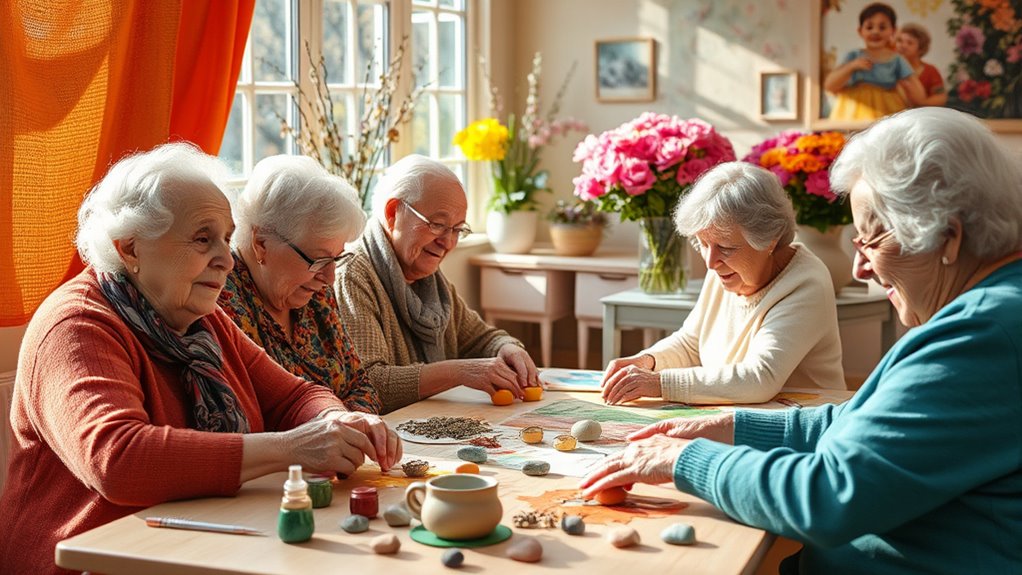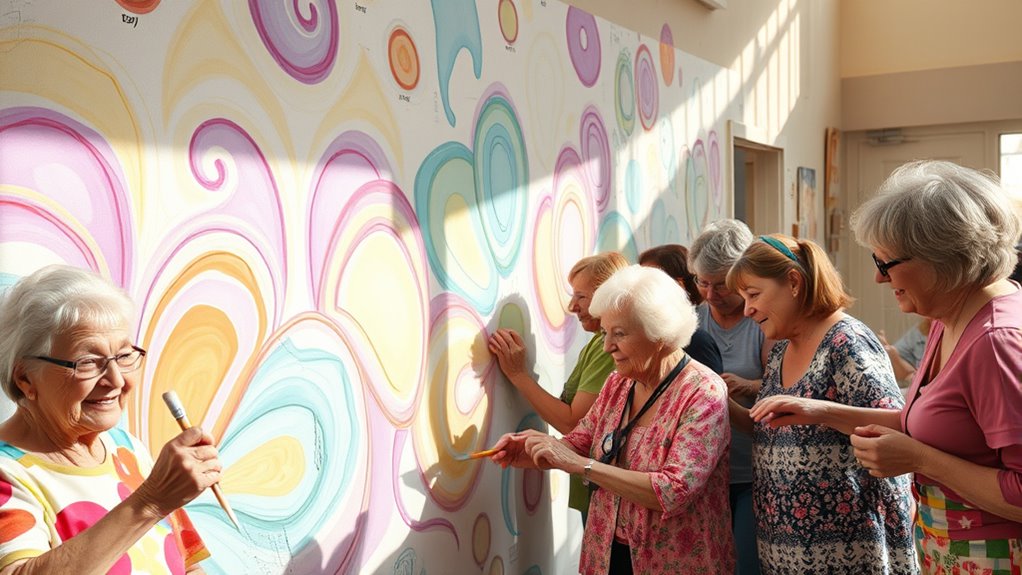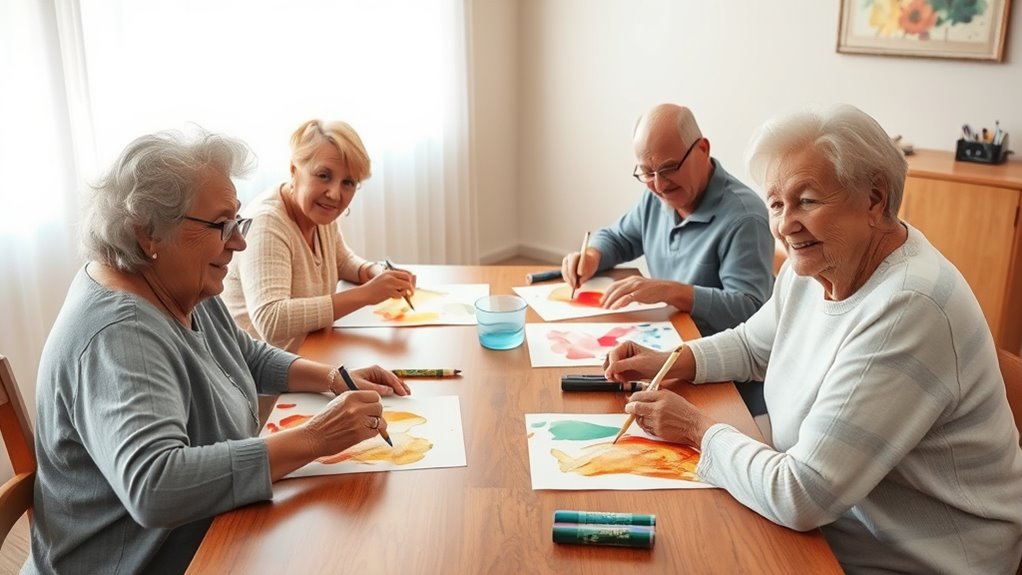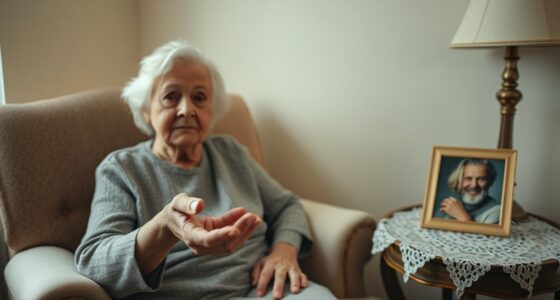Art therapy projects for dementia often involve sensory activities like tactile exploration with textured materials, creating familiar object collages, or using natural themes to evoke memories and promote calmness. You can also encourage collaborative murals, personal journaling with visual symbols, or simple clay exercises to support motor skills. These projects help stimulate memory, foster emotional expression, and strengthen social bonds. If you keep exploring, you’ll discover even more ways to support well-being through creative engagement.
Key Takeaways
- Incorporate sensory and tactile activities using familiar textures and objects to stimulate memory and emotional responses.
- Design collaborative projects like murals or group collages to promote social interaction and shared creativity.
- Use visual symbols and personal journals to facilitate emotional expression and reinforce identity beyond verbal communication.
- Integrate nature-inspired art, such as botanical motifs and natural materials, to evoke calmness and positive memories.
- Combine tactile, visual, and natural elements in tailored activities to enhance self-awareness, memory, and emotional well-being.
Sensory Art Activities to Stimulate Memory

Sensory art activities engage multiple senses to help stimulate memory in individuals with dementia. By encouraging tactile exploration, you allow them to touch and feel different textures, which can trigger familiar memories and evoke emotional responses. Incorporating color recognition is also essential; you can provide vibrant paints, colored papers, or objects in various hues to help them identify and name colors. These activities promote engagement and focus, strengthening neural connections associated with sensory processing and memory. As you guide them through exploring different textures and colors, you create a safe space for reminiscence and emotional expression. Color accuracy and consistent use of familiar hues can enhance the effectiveness of these activities. Sensory art activities are simple yet powerful tools to stimulate memory and enhance overall well-being in those living with dementia.
Collaborative Mural Projects for Social Engagement

Engaging in collaborative mural projects offers a meaningful way to foster social interaction among individuals with dementia. These projects enhance group dynamics by encouraging teamwork and shared creativity. When designing a mural, consider these key points:
Collaborative murals foster social interaction and teamwork among individuals with dementia.
- Inclusive Mural Design: Guarantee everyone’s ideas are valued and incorporated.
- Clear Roles: Assign tasks suited to each participant’s abilities to boost confidence.
- Open Communication: Foster dialogue to strengthen social bonds.
- Celebration of Achievements: Display the completed mural to acknowledge collective effort.
- Recognizing social engagement as a vital component can further promote well-being and community connection.
Memory Collage Creations Using Personal Photos

Building on the sense of connection fostered through collaborative murals, creating memory collages with personal photos offers a powerful way to evoke past experiences and strengthen identity. By selecting meaningful images, you help preserve precious moments through photo preservation techniques, ensuring these memories endure. As you arrange and glue photos into collages, you facilitate memory storytelling, encouraging individuals to share the stories behind each picture. This process not only stimulates reminiscence but also promotes emotional well-being and self-awareness. You can incorporate captions or labels to deepen the narrative, making memories more vivid. Memory collages become a tangible link to the past, fostering a sense of pride and continuity. Additionally, incorporating emotional expression into the activity can further enhance emotional connection and provide comfort. Overall, this activity nurtures connection, reinforces personal identity, and provides a meaningful, creative outlet for those with dementia.
Simple Clay and Playdough Exercises for Fine Motor Skills

Simple clay and playdough exercises are effective ways to enhance fine motor skills in individuals with dementia. These activities improve hand-eye coordination and provide tactile stimulation, which can boost sensory awareness. To maximize benefits, focus on these key activities:
- Rolling and flattening dough to strengthen finger muscles.
- Pinching and squeezing to enhance grip and coordination.
- Creating simple shapes or objects to encourage precise movements.
- Using tools like cutters or stamps to add variety and challenge hand-eye coordination.
These exercises keep hands active, stimulate the senses, and promote motor control. They’re simple, engaging, and adaptable to different ability levels. Regular practice helps maintain dexterity and provides a calming, enjoyable experience for individuals with dementia. Additionally, incorporating familiar themes from cultural narratives can foster emotional connection and enrich the activity experience.
Painting With Familiar Objects and Textures

Using familiar objects and textures in painting activities can considerably enhance sensory engagement for individuals with dementia. Texture exploration allows you to introduce various materials—such as fabric, sandpaper, or leaves—that stimulate touch and evoke memories. By incorporating these textures into the painting process, you encourage your loved one to connect with their senses and express themselves creatively. Object improvisation involves using everyday items like sponges, combs, or textured tools to create unique patterns and effects on the canvas. This approach makes art accessible and enjoyable, fostering a sense of accomplishment. Exploring different textures and improvising with objects helps break down barriers, encouraging participation and enhancing emotional well-being through meaningful sensory experiences. Additionally, understanding the types of best art therapy projects can help tailor activities to individual preferences and needs.
Guided Art Sessions Using Music and Visuals

Guided art sessions that incorporate music and visuals can create a powerful, immersive experience for individuals with dementia. By combining music therapy and visual storytelling, you help evoke memories, emotions, and engagement. To maximize impact, consider these strategies:
- Use familiar songs to trigger personal memories and encourage participation.
- Incorporate visual aids like images or videos that relate to the music or theme.
- Encourage storytelling through visuals, helping individuals share their experiences.
- Keep sessions simple and adaptable, allowing participants to express themselves comfortably.
- Utilizing essential oils during sessions can enhance relaxation and emotional responses, making the experience even more enriching.
These techniques foster emotional connections and stimulate cognitive functions. The harmony of music and visuals creates an engaging environment, making art therapy accessible and meaningful for those with dementia.
Creating Personal Art Journals for Self-Expression

Creating a personal art journal gives you a space to express your thoughts and feelings freely. You can use visual symbols to represent memories or emotions, making your entries more meaningful. This process encourages you to share your personal stories in a way that’s both creative and therapeutic. Incorporating elements like horsepower of electric dirt bikes can inspire dynamic and energetic artwork within your journal.
Encouraging Personal Narratives
Encouraging personal narratives through art journals offers dementia patients a meaningful way to express their thoughts and memories. This approach fosters personal storytelling and emotional expression, helping individuals reconnect with their experiences. To facilitate this: 1. Use prompts that evoke memories or feelings. 2. Incorporate varied art materials to inspire different forms of expression. 3. Encourage regular journaling to build a storytelling habit. 4. Offer a non-judgmental space where emotions can be freely expressed. Incorporating comfort solutions for sofa beds can create a cozy environment that further supports emotional well-being during art therapy sessions.
Using Visual Symbols
Using visual symbols in personal art journals offers a powerful way for dementia patients to express themselves beyond words. Symbolic imagery allows individuals to communicate feelings or memories that might be difficult to articulate verbally. By incorporating visual storytelling, patients create a narrative through images, giving them a sense of identity and continuity. These symbols can be simple objects, colors, or abstract forms that hold personal meaning. As you guide them, encourage choosing images that resonate emotionally, helping access memories and foster self-awareness. This process not only promotes emotional expression but also enhances cognitive engagement. Additionally, focusing on vibrational energy can help align their emotional states with positive experiences, further supporting well-being. Ultimately, using visual symbols transforms the journal into a personal, meaningful space where stories are shared nonverbally, supporting both self-expression and emotional well-being.
Nature-Inspired Art Projects to Promote Calmness

Nature-inspired art projects can be a soothing and accessible way to promote calmness in individuals with dementia. Incorporating botanical motifs helps evoke familiar, comforting images that encourage relaxation. Using color therapy, you can select calming shades like greens, blues, and soft earth tones to create a peaceful atmosphere. To maximize benefits, consider these ideas:
- Paint or collage with leaves, flowers, or trees to stimulate sensory engagement.
- Use natural materials like pressed flowers or twigs for tactile involvement.
- Create simple watercolor landscapes emphasizing calming colors.
- Design botanical-themed coloring pages focusing on color therapy principles.
- Understanding the significance of symbolism in nature-themed art can deepen the therapeutic experience.
These projects foster a connection to nature, reduce anxiety, and promote mindfulness, offering therapeutic benefits through accessible and familiar imagery.
Frequently Asked Questions
How Can Art Therapy Improve Emotional Well-Being in Dementia Patients?
You can help improve emotional well-being in dementia patients by encouraging activities that promote emotional expression and memory stimulation. Art therapy allows them to communicate feelings they might struggle to verbalize, fostering a sense of achievement and connection. By engaging in creative projects, you support their emotional health, reduce anxiety, and trigger memories that reinforce their identity, ultimately enhancing their overall quality of life and emotional resilience.
What Safety Precautions Are Necessary During Art Activities for Dementia Care?
When planning activities, you need to prioritize safety measures and conduct a thorough risk assessment. Make sure the environment is clutter-free and age-appropriate supplies are used. Supervise participants closely to prevent accidents, and choose non-toxic, easy-to-handle materials. Regularly check for hazards and adjust the activity as needed. By implementing these precautions, you create a safe space that encourages engagement while minimizing risks during art activities.
How Do You Tailor Art Projects to Different Stages of Dementia?
You tailor activities by using personalized activity adaptations that suit each individual’s abilities and preferences. Incorporate cognitive engagement techniques to stimulate memory and thinking skills, adjusting complexity as dementia progresses. For early stages, choose more detailed projects, while simpler, sensory-based activities work better in later stages. Your goal is to keep participants engaged and comfortable, fostering a sense of accomplishment and connection through activities that evolve with their cognitive needs.
Are There Specific Art Materials Best Suited for Dementia Patients?
Imagine a vintage typewriter—each key offers tactile feedback. For dementia patients, choose art materials that promote sensory engagement, like soft clay, textured papers, and chunky crayons. Adaptive tools like easy-grip brushes or scissors help them participate comfortably. The right materials enhance creativity and confidence, making art an accessible and meaningful experience. Focus on simplicity and sensory richness to support their unique needs and abilities.
How Can Family Members Support Art Therapy at Home?
You can support art therapy at home by actively involving your family and creating routines around art activities. Encourage everyone to participate regularly, making art a consistent and comforting part of your loved one’s day. Keep supplies simple and accessible, and focus on the process rather than the outcome. Your involvement helps boost their engagement, provides emotional support, and fosters a sense of connection, making art therapy more effective and enjoyable.
Conclusion
Engaging in art therapy projects can be a gentle bridge to reconnect with memories and express yourself. These activities act as keys revealing hidden thoughts and feelings, fostering joy and social bonds. Remember, your creativity is a lighthouse guiding you through the fog of dementia, illuminating moments of clarity and calm. Embrace these projects with an open heart, and let your imagination be the compass that leads you to peace and connection.









